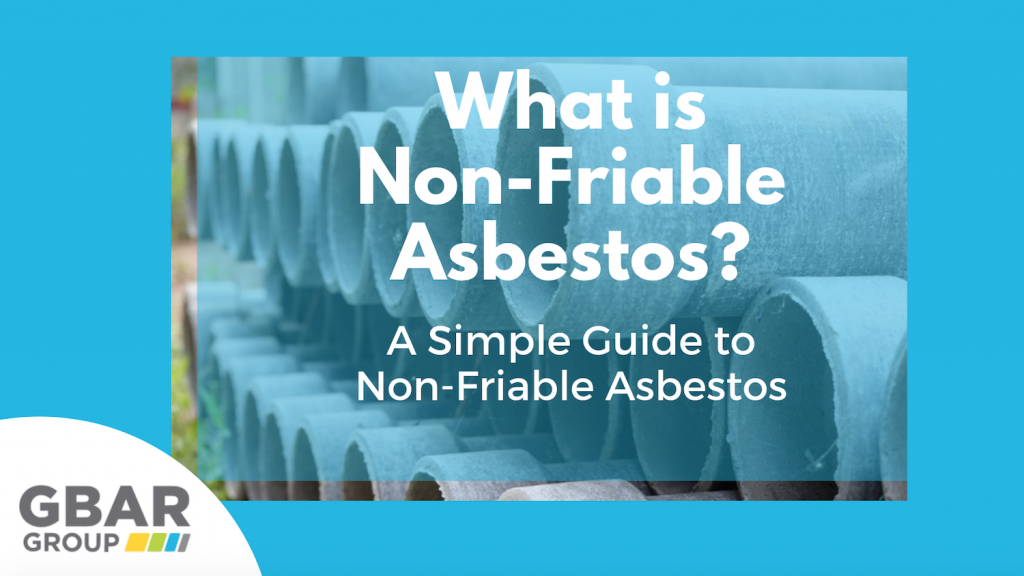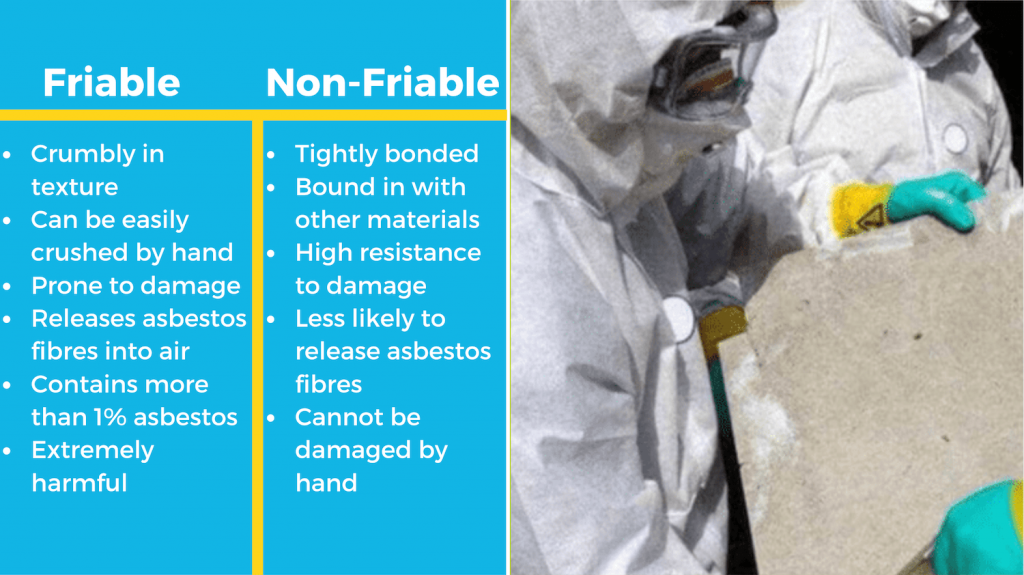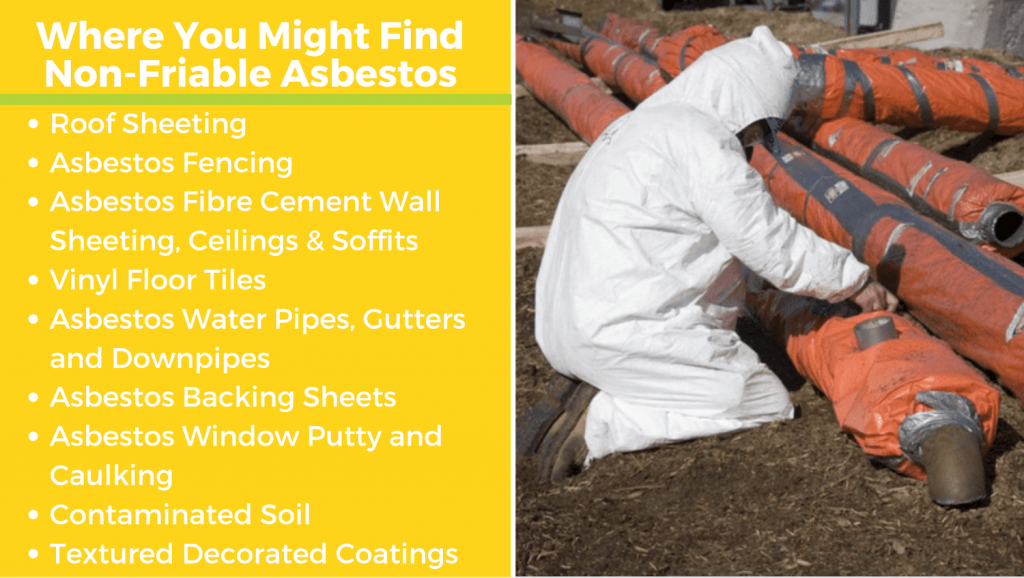
Non-friable asbestos material refers to asbestos that is resistant to damage and is unlikely to release harmful asbestos fibres into the air. Non-friable asbestos is characterised by the fact that, unlike friable asbestos materials, it cannot be damaged or crushed by the human hand.
Asbestos is a general term to describe a family of naturally occurring minerals. The most common forms of asbestos found in Australia are chrysotile (white asbestos), amosite (brown asbestos) and crocidolite (blue asbestos). Used both independently or mixed in with other materials, asbestos is an incredibly dangerous material that can be divided into two types: friable and non-friable.
Asbestos was first introduced into Australian industry in the early 1900s and was widely used in construction and manufacturing up until the 1990s. Asbestos was banned in Australia in December 2003 when the damaging effects of asbestos exposure were too great to ignore. Known for its ‘idyllic’ properties, asbestos was favoured due to its strength, heat and chemical resistance, durability, malleability, fireproofing and insulation qualities.
Australia’s consumption of the material accounted for one of the highest users per capita. The mining industry allowed asbestos to be an affordable and accessible material from the 1930s until the late 1980s, and Asbestos was once used in Australia in more than 3,000 different products. Eventually, asbestos materials were phased out and finally banned in December of 2003 due to the direct connection between asbestos fibres and serious health conditions. Australia now has one of the highest incidence rates of mesothelioma in the world.

Key Characteristics of Non-Friable Asbestos
One of the key factors contributing to asbestos being so dangerous is the friability of asbestos. The more friable asbestos is, the more likely it is to release the toxic fibres. The less friable the material is, the less likely it is that asbestos fibres will become airborne.
Non-Friable asbestos refers to asbestos that is more resistant to damage and abrasion than friable asbestos, so is less likely to release harmful fibres into the air. The asbestos fibres within non-friable materials are tightly bound, sealed and mixed in with other materials, such as cement.
Also known as bonded asbestos, non-friable asbestos will not be damaged with little force and cannot be easily disturbed. Non-friable asbestos materials are harder to break, and therefore, harder for the fibres to be released into the air and become airborne. In general, non-friable asbestos materials pose a lower risk to health than friable asbestos materials.
Technically speaking, if non-friable asbestos-containing material is in good condition and completely undisturbed, it does not pose a threat to human health. However, although it is less dangerous than friable asbestos, non-friable materials should still be treated with caution and disposed of properly.
What Happens When Non-Friable Asbestos is Disturbed?
Asbestos is most harmful when the fibres become airborne. Once the fibres are released into the air, they can be easily inhaled or ingested by humans. This is how asbestos exposure occurs. Breathing in or swallowing asbestos particles is what leads to a host of asbestos disease including asbestosis, mesothelioma, and lung cancer.

Non-friable asbestos can quickly and easily transition into friable asbestos once the material has been disturbed. Damaging, wearing, and ageing can all contribute to a non-friable material becoming friable and very dangerous.
Cutting, sawing, sanding, drilling, breaking and handling a non-friable asbestos material will also disturb the material and consequently make it friable. More than one-third of Australian homes contain asbestos in some form – so if you’re planning to do some renovations or demolition work, it’s important to test all materials for asbestos before potentially turning non-friable asbestos friable and putting your health at risk.
Examples of Non-Friable Asbestos
Some of the most common types of non-friable asbestos materials include:
- Roof Sheeting
- Asbestos Fencing
- Asbestos Fibre Cement Wall Sheeting, Ceilings & Soffits
- Vinyl Floor Tiles
- Asbestos Water Pipes, Gutters and Downpipes
- Asbestos Backing Sheets
- Asbestos Window Putty and Caulking
- Contaminated Soil
- Textured Decorated Coatings
- Bitumen Products

Risks of Non-Friable Asbestos
The main risk of non-friable asbestos materials is that they will become damaged and deteriorate with time, increasing the friability. Water damage, continual vibration, ageing, and physical impact can break and disturb the materials, releasing the asbestos fibres. If non-friable asbestos materials are completely left alone and do not wear with age, they will not release asbestos fibres. However, there is no way of guaranteeing a material is completely safe from friability without appropriate asbestos testing. It’s best to have all asbestos materials removed and remediated to ensure damaging asbestos exposure does not occur.
Asbestos exposure is directly linked to the development of a number of critical health conditions. Because it is so difficult to destroy asbestos fibres, the body cannot break them down or remove them once they become lodged in the lungs and body tissue. They become trapped in the lung membranes, where over time, they cause significant health problems.
The three main diseases associated with asbestos exposure include:
1.Asbestosis – a chronic, non-cancerous respiratory disease. Inhalation of asbestos fibres aggravates the lung tissues, resulting in long-term scarring. Symptoms of asbestosis include shortness of breath, coughing, and wheezing. There is no effective treatment for asbestos, and the disease can be debilitating, disabling and fatal.
2. Lung Cancer – lung cancer is the largest contributor to deaths related to asbestos exposure. The incidence of lung cancer in those who are directly involved in the mining, milling, manufacturing and use of asbestos is much higher than in the general population. The combination of smoking and asbestos exposure will increase the chances of lung cancer developing.
3. Mesothelioma – a rare, aggressive form of cancer that develops in the thin membrane lining of vital organs. More commonly found in the linings of the lungs, chest, and abdomen, mesothelioma is directly correlated with asbestos exposure. Malignant mesothelioma is a fatal disease, with approximately two new cases of mesothelioma, are diagnosed every day in Australia. We now have one of the highest incidence rates of mesothelioma in the world.
There are no safe levels of asbestos exposure. However, the risk of developing an asbestos-related illness is increased with higher amounts of asbestos and increased time of exposure. Asbestos-related illnesses take years to develop, with the average latency period between exposure and diagnosis being about 30 years.
Handling Non-Friable Asbestos
In some states of Australia, homeowners are permitted to remove non-friable asbestos under the provision of it being under 10m2. That being said, it is strongly advised against by both the Australian Department of Health and WorkSafe Australia. All friable asbestos materials need to be assessed, removed and disposed of by an accredited asbestos specialist, and the same care should be taken for non-friable materials too.
Handling non-friable asbestos is incredibly hazardous as it could quite easily become friable. The risk of handling such material without the appropriate licensing, training and asbestos experience is far too great. Relying on professionals such as GBAR Group will ensure your property is safe from asbestos and the materials do not further contaminate.
GBAR Group is Australia’s most trusted Asbestos Removal and Hazardous Waste Remediation group. Our asbestos specialists are rigorously trained to ensure correct asbestos removal, to minimise attendant risks as much as possible. We’ll assess all asbestos materials, assist in the identification of both friable and non-friable materials, measure and quantify the risk, provide advice and a request quote on removal options undertaken in conjunction with occupational hygienists.
If you wish to proceed, we will safely remove and dispose of the asbestos, and remediate the contaminated site. At GBAR Group, we pride ourselves on our commitment to high-quality removal and providing safety to our clients.






